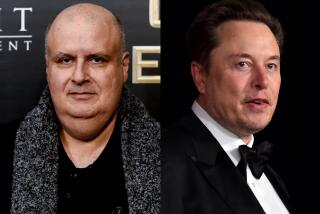Robert Kinoshita dies at 100; designer of famed film robots
- Share via
Robert Kinoshita, who designed beloved film and TV robot characters, including the bubble-headed “Lost in Space” robot who made “Danger, Will Robinson” a catchphrase of the 1960s, has died. He was 100.
Kinoshita died Dec. 9 at an assisted living facility in Torrance of congestive heart failure, his daughter, Pat Aoki, said Wednesday.
The “Lost in Space” robot had a deep male voice but no name — though aficionados refer to him by the model designation B9 that was visible in an episode. The machine had sustained popularity long after the 1965-68 series, and to this day there are B9 fan clubs, , including those that build meticulous re-creations of the robot.
By looks and even personality, B9’s ancestor was Robby, a robot that Kinoshita helped create for the 1956 MGM sci-fi classic “Forbidden Planet.”
Kinoshita was a designing draftsman at the studio when Robby was being developed.
“We had five guys designing, and we just knocked out must have been a couple thousand drawings,” Kinoshita said in a 2006 short documentary, “Robby the Robot.” “So I said, ‘The hell with it, I’m going to make me a model.’”
The studio went with it. When fully built, Robby had a plethora of flashing lights, spinning antennas and piston-like mechanisms. But none of it was random.
“Robby was a great design,” Oscar-winning special effects artist John Dykstra said in the documentary. “He had a head, shoulders, feet, arms. You knew where to look to see him express himself.”
Using built-in apparatus, Robby was depicted as being able to fulfill a wide range of requests. But perhaps his neatest trick was stealing scenes from the cast that included Walter Pidgeon and Leslie Nielsen.
“You can’t think of ‘Forbidden Planet,’ ” Nielsen said in the documentary, “without thinking of Robby the Robot.”
Kinoshita was born Feb. 24, 1914, in Los Angeles as a Nisei first-generation Japanese American and grew up in Boyle Heights. He graduated from Roosevelt High School and went to USC to study architecture. But at the school, he saw an exhibit of sketches by an alumnus who worked for a movie studio.
“I fell in love with them,” he told the Rafu Shimpo newspaper. “I thought, ‘This is for me, this designing for motion pictures.’ ”
He graduated in 1940 with a bachelor’s degree in architecture and design, and found work with the Department of Water and Power. When it became clear that Japanese Americans would be sent to internment camps during World War II, he and his girlfriend, Lillian Matsuyama, quickly married to avoid being separated. They were sent to the Poston camp in Arizona.
Returning to Los Angeles after the war, Kinoshita worked for several producing companies. In TV, he was art director on several shows produced by Ziv-United Artists, including “Sea Hunt” and “Bat Masterson.” “Lost In Space” creator Irwin Allen hired him to create that show’s robot, who shared some characteristics with Robby but was more versatile.
The character was central to numerous episodes in which he saved the space-traveling Robinson family — and especially young son Will — from peril. Toy models of the robot were big sellers, which delighted Kinoshita, even though he got no share of the sales.
“I think it’s tremendous,” he said of the toys in 2000.
In addition to his daughter, he is survived by two grandchildren, four great-grandchildren and one great-great grandchild.
Twitter @davidcolker
More to Read
Start your day right
Sign up for Essential California for the L.A. Times biggest news, features and recommendations in your inbox six days a week.
You may occasionally receive promotional content from the Los Angeles Times.






